PREVIOUS
No Confidence Motion
August 23 , 2023
706 days
6738
0
(இதன் தமிழ் வடிவத்திற்கு இங்கே கொடுக்கவும்)
No Confidence Motion
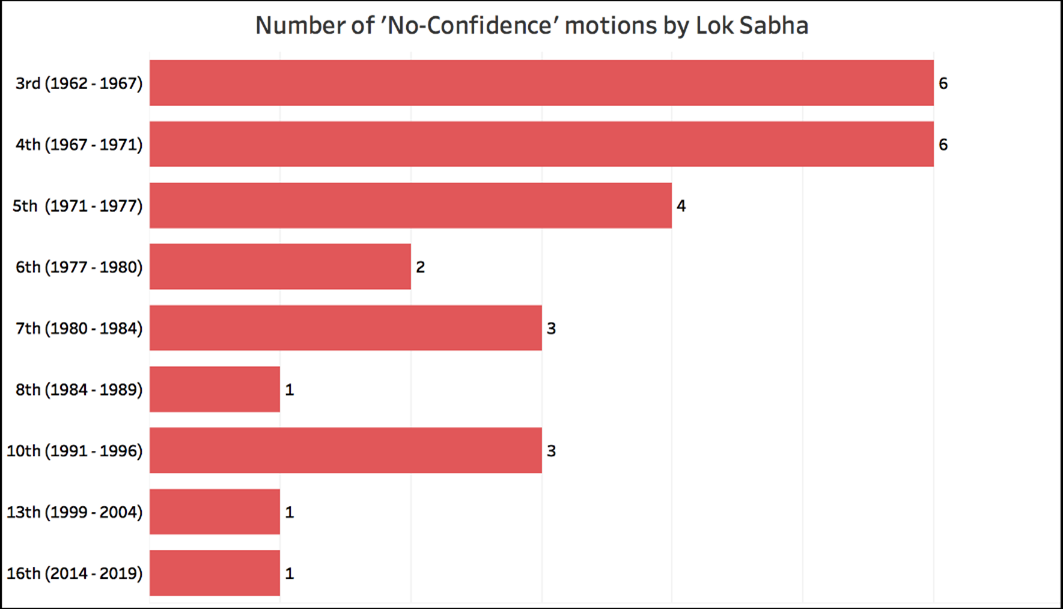
- It is customary to pass a no-confidence motion, when opposition parties lose faith in government or majority.
- Through this resolution, the opposition parties are challenging the government.
- No Confidence Motion is a formal proposal moved by the opposition against the ruling government in the Lok Sabha under Rule 198 of the Rules of Procedure and Conduct of Business in Lok Sabha.
- According to the Motion, if the ruling party fails to prove its majority in Lok Sabha after the passing of the motion, it must resign.
- The No Confidence Motion is an important tool against the Council of Ministers in the Lok Sabha.
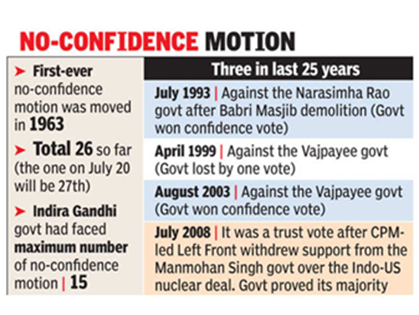
- At least 50 members of the Lok Sabha should support the motion.
- It declares the full council of ministers unfit to serve in leadership roles because of their shortcomings or failure to fulfil their responsibilities.
- It can be adopted in the Lok Sabha without a prior justification.
- As per Rule 198 of the rules of Procedure and Conduct of Lok Sabha, there is no need to state the reason for requesting the No Confidence Motion by the opposition before Lok Sabha adopts it.
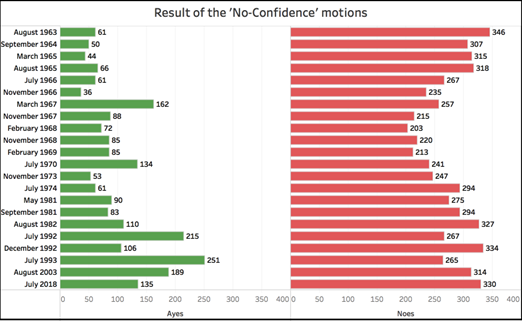
- The Lok Sabha is the council of ministers’ primary accountability body, per Article 75 of the Constitution.
- As long as the majority of Lok Sabha MPs continue to support the ministry, it will continue in power.
- The No Confidence Motion is approved if 51% of the house members vote in favor of it.
- The opposition can ask the government to demonstrate its majority after bringing a No Confidence Motion, or it must introduce a vote of confidence to do so.
- The opposition occasionally introduces the No Confidence Motion to compel the government to address crucial matters.
- Recently, the Finance bill was passed directly, without debate, via the guillotine provision.
- This action was taken for the first time in the Lok Sabha’s history.
- And many other important decisions have been taken without Legislative scrutiny.
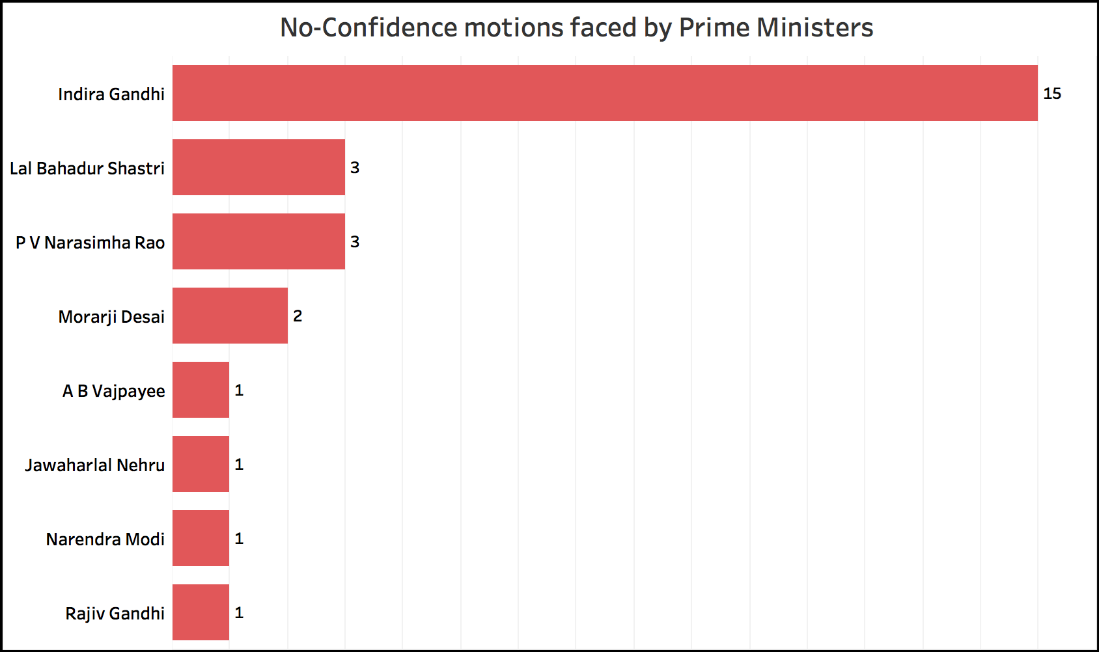
Rules on No-Confidence Motion
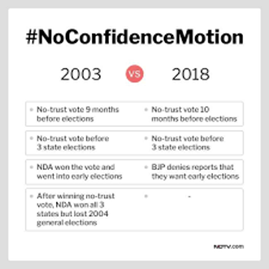
- The Code of Conduct of the Lok Sabha, 198 specifies the provisions for the motion of no-confidence.
- Any member of Parliament can pass a no-confidence motion against the government.
- The resolution requires the support of at least 50 members.
- The decision should be written.
- It should have the signature of a member who makes the decision.
- The resolution should be submitted to the Speaker on the day of the Assembly.
- The member should also give a written notice of the resolution by 10 am.
- The Presiding Officer will read it.
- After the no-confidence motion has been against by the government, the Speaker will decide whether or not the resolution will be subject to discussion.
- If the Speaker accepts the resolution, the date for the debate on the no-confidence motion will be decided.
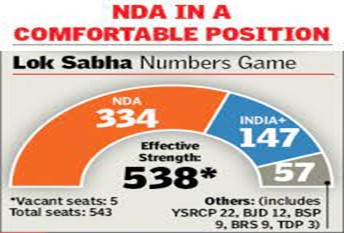
Historical Background
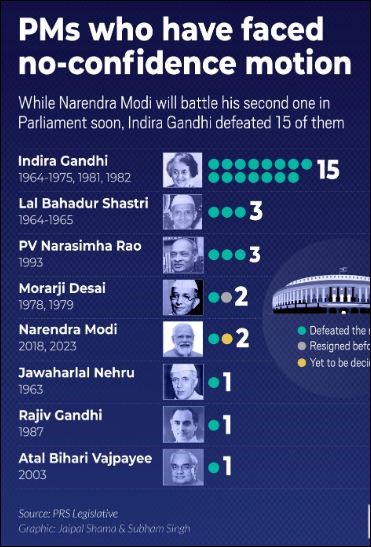
- So far, 28 no-confidence motion has been moved in the Lok Sabha.
- In 1963, For the first time a no-confidence motion was brought against Jawaharlal Nehru government and defeated.
- It was introduced by JB Kripalini.
- During 1964-1975, 15 times no-confidence motion were introduced.
- Out of these, 3 resolutions were introduced and defeated against the Government of Lal Bahadur Shastri while 12 resolutions were introduced and defeated against the Government of Indira Gandhi.
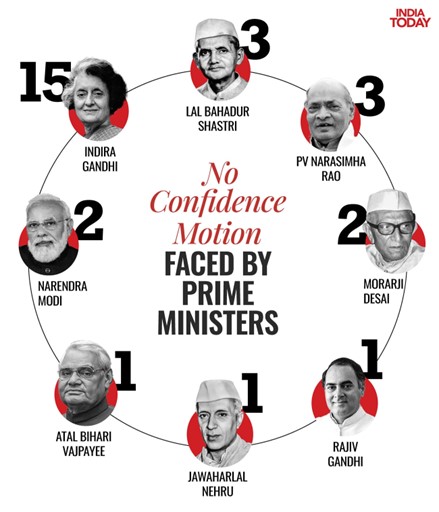
- Morarji Desai, who was in power during 1977-79, faced no-confidence motion twice.
- He won the first time.
- But he was forced to resign because he could not muster enough votes for the second time.
- In 1981-1982, Indira Gandhi defeated the no-confidence motion three times.
- In 1987 Rajiv Gandhi defeated the no-confidence motion.
- PV Narasimha Rao, Prime Minister from 1991 to 96, defeated the no-confidence motion three times.
- In 2003, Atal Bihari Vajpayee government defeated the no-confidence motion brought against it.
- Prime Minister Narendra Modi has won the no-confidence motion ever since 2014, for the first time in 2018, and for the second time in 2023.
- The short-lived prime ministers V P Singh (1989-90), Deve Gowda (1996-97) and Vajpayee (1998-99) passed a resolution seeking confidence and lost.
- So, they resigned after that.
- In 2008, Manmohan Singh moved a resolution seeking confidence and succeeded.
Procedure to move a “No Confidence Motion”
- The procedure is specified under Rule 198 of the Lok Sabha.
- The Constitution of India does not mention either a Confidence or a No Confidence Motion.
- But, Article 75 does specify that the Council of Ministers shall be collectively responsible to the Lok Sabha.
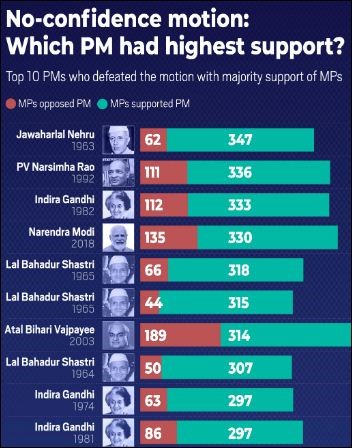
- A motion of No Confidence can be introduced only in the Lok Sabha and by the opposition.
- It can be admitted when a minimum of 50 members support the motion in the house.
- According to Rule 198(1)(a): Leave to make the motion shall be asked for by the member when called by the Speaker.
- According to Rule 198(1)(b): The member asking for such leave would need to give a written notice of the motion to the Secretary-General of the Lok Sabha by 10 AM on the day he/she proposes to move the motion.
- Rule 198(2) states that if the Speaker is of the opinion that the motion is in order, he/she shall read the motion to the house, requesting those members who are in favour of it to rise in their places.
- If at least 50 members support the motion, the Speaker declares that the leave is granted.
- According to Rule 198(3), if leave is granted the Speaker may allot a day/part of a day/days for discussion of the motion.
- This is done after considering the state of business in the house.
- According to Rule 198(4): the Speaker shall put every question necessary to determine the decision of the house on the motion at the appointed hour on the allotted day.
- According to Rule 198(5): the Speaker may prescribe a time limit for speeches.
- If the motion is passed in the House, the Government is bound to vacate the office.
- If the motion is failed in the house, then the Government can continue in office without any trouble
Rules for a Confidence Motion
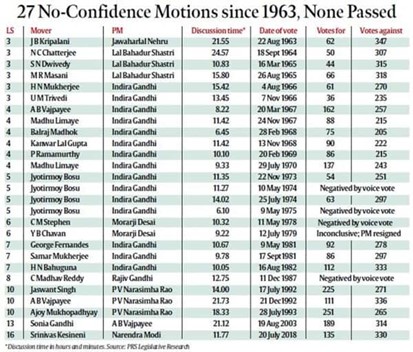
- There is no special provision in the rules for a Confidence Motion.
- Such a motion is moved as an ordinary motion under Rule 184.
- After the general election, when no party has a clear majority, the President may appoint a Prime Minister.
- This person is expected to prove his/her majority through a Confidence Motion.
- For instance, President KR Narayanan appointed Atal Bihari Vajpayee as Prime Minister on the basis of written support by a majority of MPs.
- But he had asked him to secure the confidence of Parliament in 10 days.
- Ever since the first Lok Sabha elections in 1952, the No Confidence Motion has been presented several times in Parliament.
- Many of these attempts to bring down the Government have failed.
- But there are instances when the No Confidence Motion did get passed.
- Opposition parties also use it as a tool to mount pressure on the Government to make the ruling dispensation discuss matters of pressing national importance.
- The No Confidence Motion is an important function of Parliamentary proceedings.
- Members who back the No Confidence Motion indicate that they have lost the Confidence in the Government.
- The no-confidence motion is once taken, it can be brought back in the next six months.
Leave a Reply
Your Comment is awaiting moderation.


